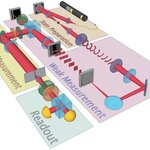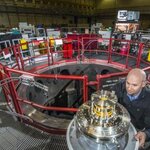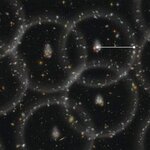Physics

Measuring a 27-dimensional quantum state is a time-consuming, multistage process using a technique called quantum tomography, which is similar to creating a 3D image from many 2D ones.
Researchers have instead been able to apply direct measurement to do this in a single experiment with no post-processing. In a new paper they demonstrate direct measurements of the quantum state associated with the orbital-angular momentum.
The direct measurement technique offers a way to directly determine the state of a quantum system. It was first developed in 2011 by scientists at the National Research…

"Statistical power does not corrupt"
Leland Wilkinson, "Statistical Methods in Psychology Journals", in American Psychologist, August 1999.
[Note: "power" in the context of statistical tests measures the probability that a test rejects the null hypothesis when the alternate hypothesis is true). Thanks to Michael Schmitt for pointing out the quote]

Tetraquarks are hypothetical particles made up by four quarks (two quarks and two antiquarks). Unlike mesons (quark-antiquark pairs) and baryons (three-quark or three-antiquark systems), the quarks in a tetraquark are quite loosely bound within their confinement volume by strong interactions, as can be calculated with the help of quantum chromodynamics. Their tendence to separate into two quark-antiquark systems should yield a very short lifetime, making their observation quite difficult. However, some tentative evidence for their existence exists.
A few months ago I was obliged by Marek…

In Italy the debate over the escape of brilliant young scientists to foreign countries has been going on for decades now. Italians like to debate, much less to solve their own problems. So although the problem is clearly identified and a recipe to solve it is evident, nobody does anything to implement the solution. Which, of course, would be to raise salaries to researchers and allow for quicker and easier ways to access a career for young post-docs.
A confirmation that Italians have the potential to be good scientists, and that their better exploitation would bring dividends to their country…

I will try to keep my Newtonian wig on. Digressions will be in well-defined sidebars. Time to serve the meat and potatoes.
The Action for the Newtonian Gravitational Field
Two things go into this action: a mass density and a scalar field:
I have chosen to work with a dimensionless source potential. Vary the action with respect to the potential. Use the Euler-Lagrange equation to generate the field equations:
The general solution is - wait, there is no general solution. Solutions always depend on the boundary conditions. Let's work on a simple case: outside of a spherically…

The Z machine at Sandia National Laboratories is moving us toward a fusion future by stepping into the past - in this case using a 19th century device called a Helmholz coil, which is a pair of circular coils on a common axis with equal currents flowing in the same sense and that produces a nearly uniform magnetic field when electrified.
In recent experiments, two Helmholz coils, installed to provide a secondary magnetic field to Z's huge one, unexpectedly altered and slowed the growth of magneto-Rayleigh-Taylor instabilities, an unavoidable, game-ending plasma distortion that usually…

Today the Baryon Oscillation Spectroscopic Survey (BOSS) Collaboration announced that they have measured the scale of the universe to an accuracy of one percent.
BOSS is the largest program in the third Sloan Digital Sky Survey (SDSS-III). Since 2009, BOSS has used the Sloan Foundation Telescope at the Apache Point Observatory in New Mexico to record high-precision spectra of well over a million galaxies with redshifts from 0.2 to 0.7, looking back over six billion years into the universe's past.
"One-percent accuracy in the scale of the universe is the most precise such…

At the 1962 Rochester conference in Geneva, the prediction that a particle later called the Omega minus should exist, already proposed in a paper by Glashow and Sakurai, was not considered important enough to be mentioned in any invited or contributed talk. It was mentioned in a comment from the floor by Gell-Mann. The paper proposing the existence of quarks was accepted by Physics Letters only because it had Gell-Mann's name on it. The editor said, "The paper looks crazy, but if I accept it and it is nonsense, everyone will blame Gell-Mann and not Physics Letters. If I reject it and it turns…

Have you ever seen a demonstration of any of the principles of General Relativity? What about The "famous" "rubber sheet" analogy, where a heavy ball, like a bowling ball, is placed on a rubber sheet? Of course, the rubber sheet is stretched as the heavy ball "weighs down" on it, creating a large indentation, like a funnel shape. This is almost invariably followed by placing a small, far lighter ball on the sheet, with enough transverse velocity that it "orbits" the larger, heavier ball.
Well, who would have guessed that the rubber sheet demonstration does not reproduce the…

In a guest post written three years ago Giorgio Chiarelli told us the story of how the CDF detector saw its first proton-antiproton collisions, during the night of October 13th 1985. It was a very important moment for the history of the collaboration, the start of a data collection campaign that would last over a quarter of a century. Below I wish to tell you the story of one of the worst radiological incidents in the history of the experiment, which happened a few months after those first collisions were recorded.
---
The twentyone collisions collected in the course of that short engineering…